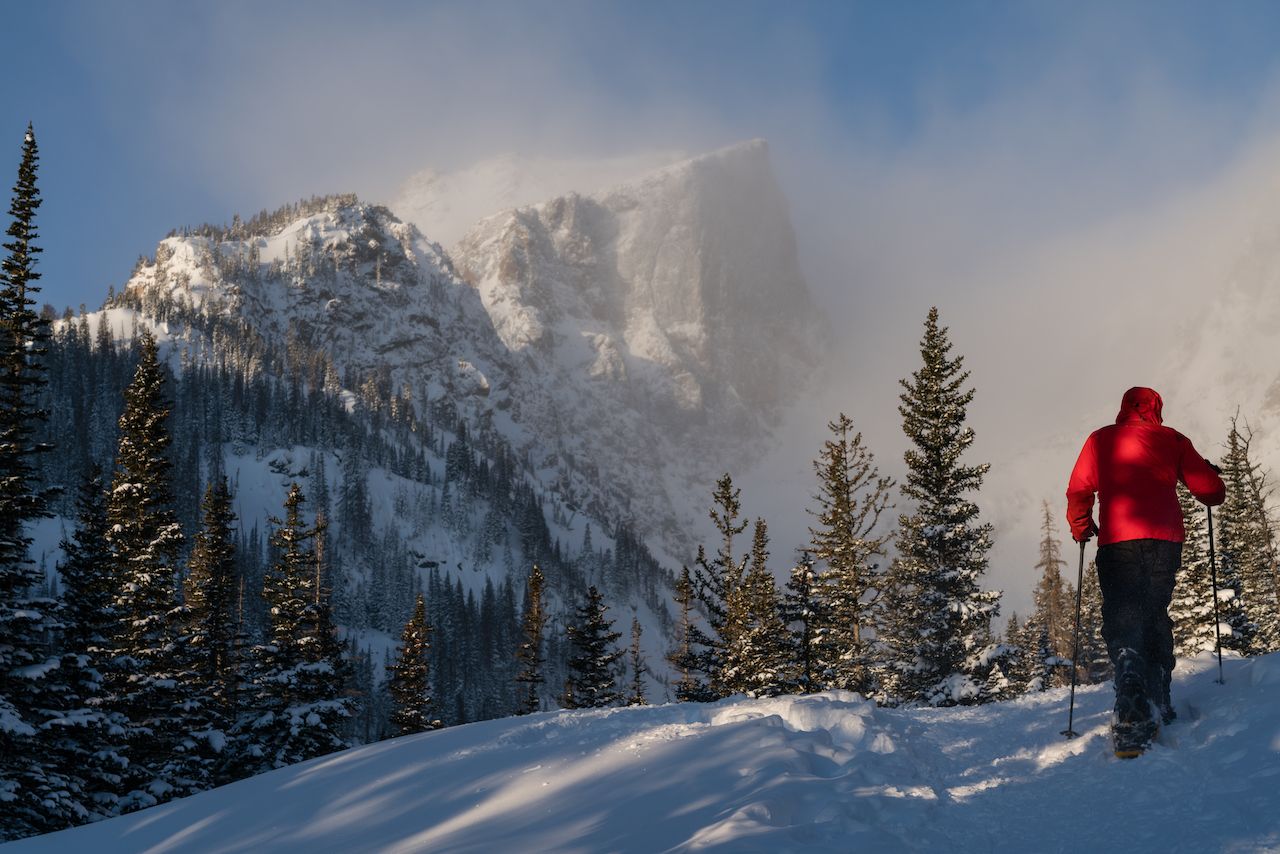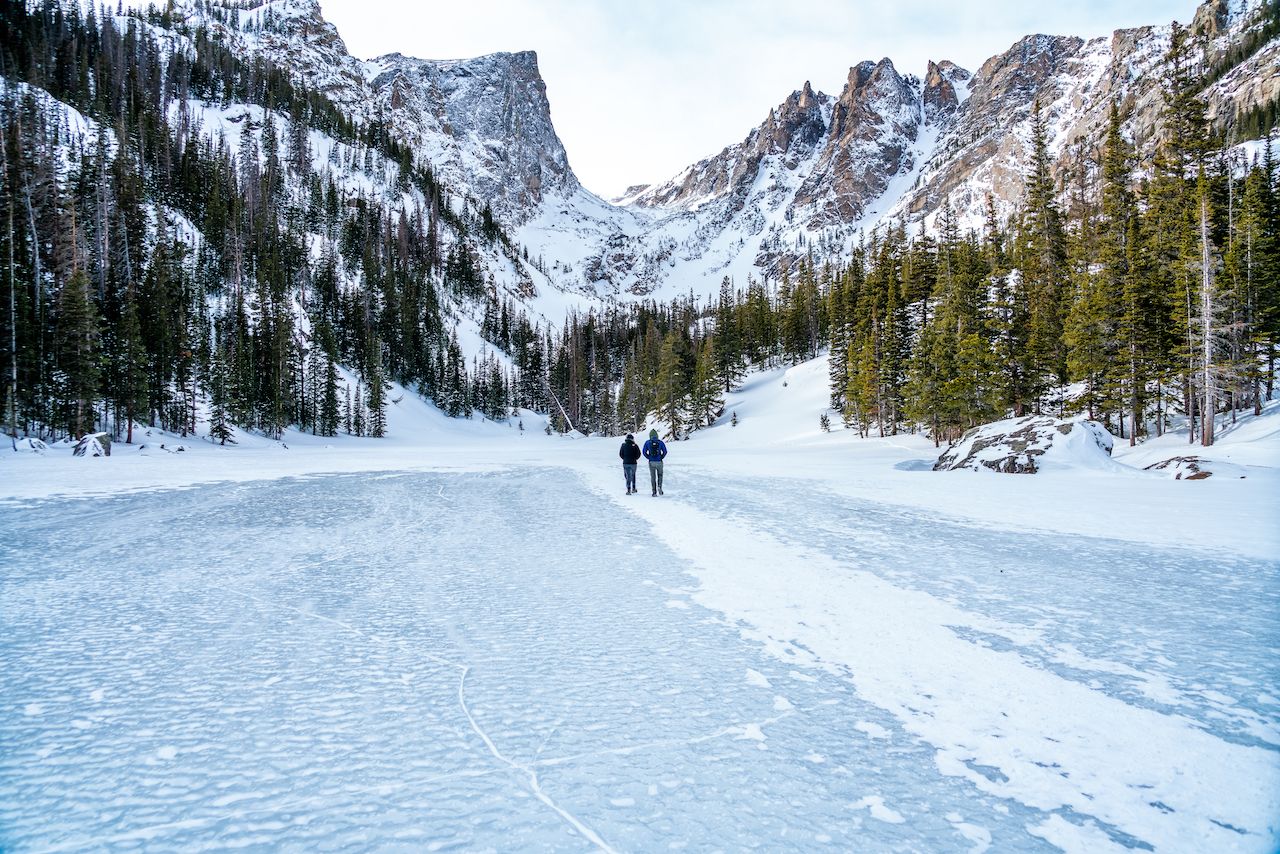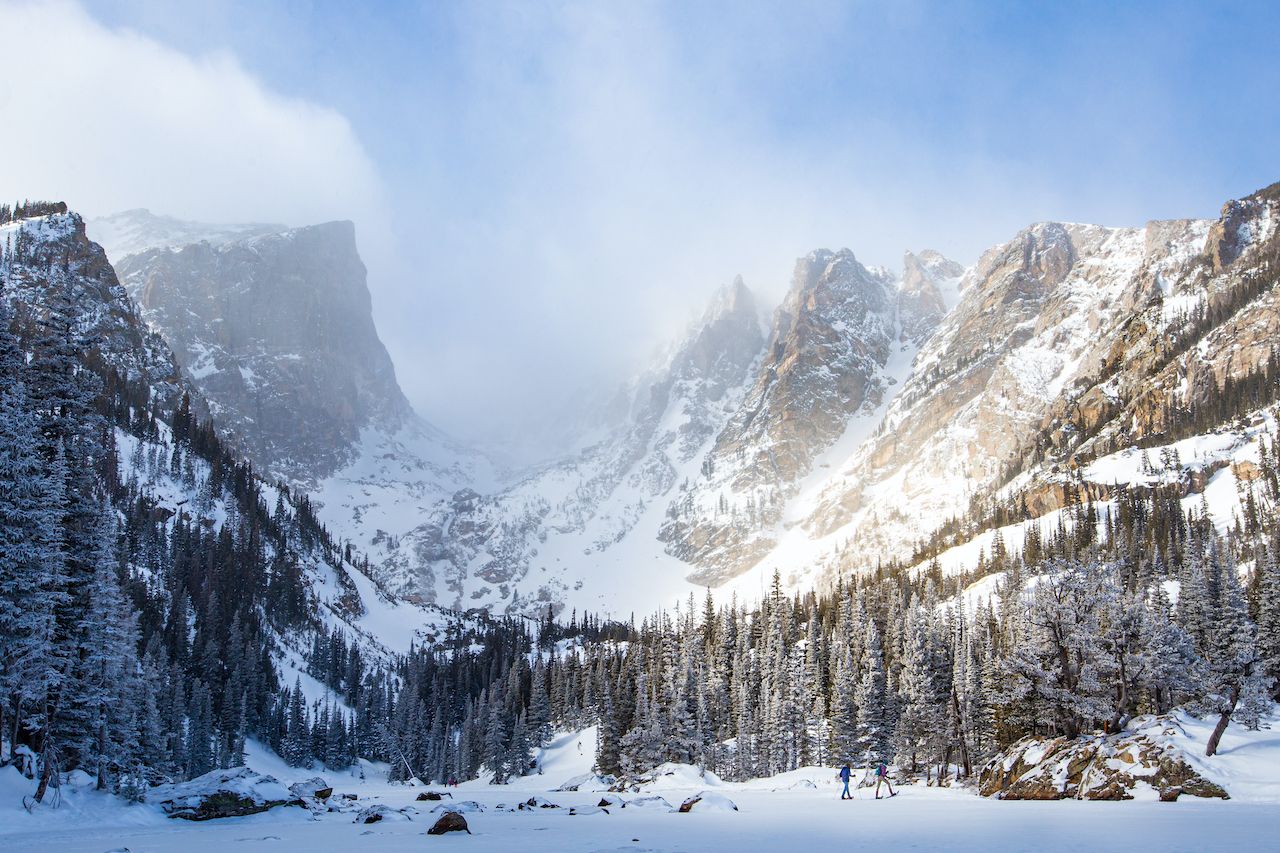Rocky Mountain National Park’s winter season is generally defined as the time period when the main road through the park, Trail Ridge Road, is closed from the Colorado River trailhead on the west side of the park to Many Parks Curve on the east side. Snow generally closes the road from late October through the last week of May, making it impossible to drive all the way through the park. Open and close dates vary by season, but you’ll need to plan in advance to make sure the area you hope to reach is accessible.
Most winter activities are accessed from the east entrance, from the nearby town of Estes Park. Temperatures typically hover in the 20s and 30s Fahrenheit, necessitating winter and snow-appropriate clothing no matter what your day entails. Daily visitor numbers drop from over 20,000 in summer to around 3,000 in winter, leaving a lot of open space — though most visitors tend to congregate in a few areas.
Resources and tips:
- If you plan to ski or snowboard, visit the Front Range Zone avalanche daily conditions report from the Colorado Avalanche Information Center.
- Skiers and snowboarders should consult our backcountry ski guide to ensure all gear and safety precautions are taken.
- When Trail Ridge Road is closed, it takes three hours to drive between the east entrance and the west entrance.
- The west side of the park, accessible from the town of Grand Lake, sees more early-season snowfall. So it may be a better choice for snowshoeing and winter sightseeing in November and December, while hiking is still possible on the park’s east side.

Photo: Brian Wolski/Shutterstock
Snowshoeing — The best way to immerse yourself in the park’s white wilderness is on a pair of snowshoes. At just over one mile round-trip, the trail from the easy-to-reach Bear Lake to Nymph Lake is the perfect warm-up or light family excursion. If the team is amped for more, take the Lumpy Ridge Trail to Gem Lake, about 1.8 miles round-trip. Photographers should take the short Sprague Lake Loop and snap stills of the snow-covered Continental Divide. Here, snowmelt on the east side of the Divide flows toward the Gulf of Mexico and the Atlantic Ocean, while snowmelt on the west side heads toward the Pacific. For a full-day excursion with a scenic picnic lunch, take the Pool Loop Trails to Cub Lake, which is six miles round-trip. You’ll pass numerous frozen waterfalls en route.
Another option is to consider going with a ranger. The west side has two different snowshoe programs once a week, one for beginners and one for intermediates, both heading into the Kawuneeche Valley; the east side offers a two-hour ecology walk three times a week, usually around the Bear Lake area. Snowshoeing doesn’t really require guidance, but it’s nice to try if you’re unfamiliar with the area, and your guide will throw oodles of information your way. The programs fill up, so reserve in advance if you can, by stopping into a visitor center or calling (970) 586-1206. Snowshoes are available for rent in Grand Lake and Estes Park.
Backcountry skiing and snowboarding — The park operated the Hidden Valley Ski Area until 1991. Though there are no longer skier services available, the 1,000-plus acres of open bowl and glade skiing remain one of the most popular destinations for backcountry skiing and snowboarding on Colorado’s front range. Skiers can snowshoe or use uphill touring equipment to climb from the parking area as high as they’d like to go, crossing the closed highway into an open bowl of powder above. More challenging backcountry skiing and snowboarding is found off Flattop Mountain, with hike-to runs accessed from Bear Lake called The Drift, North Bowl, Ptarmigan Glacier, and local-legend Corral Couloir.

Photo: CreatingEzra/Shutterstock
Cross-country skiing — Cross-country skiers have access to Trail Ridge Road as far as the Nordic track is established, or further if they’re willing to break trail. All accessible hiking trails are open to Nordic skiers, with the best access on the west side, particularly early and late in the season. Try the Keyhole, Longs Peak, Mills Lake, and Flattop Mountain trails.
Winter camping — Three campgrounds inside the park stay open through the winter. Those willing to brave below-freezing temperatures have access to Timber Creek, Moraine Park, and Longs Peak campgrounds for $14 per night, each with easy access to snowshoeing and cross-country ski trails. Be prepared with food, adequate camping gear, and water, as there are no services open at the campgrounds.

Photo: thanasarn/Shutterstock
Sledding — The hill bottom at Hidden Valley serves as the park’s sledding hill. The parking area is easy to access and is right at the base of the sledding area. Keep an eye out for backcountry skiers, however, as many park in the lot to access the terrain above. The National Park Service notes that only plastic sleds are allowed — which you can rent in Estes Park and Grand Lake — so leave the toboggan at home. Hidden Valley is accessible from the Beaver Meadows entrance and is open from 10:00 AM to 4:00 PM. It’s customary to build snowmen, too, of course.
Ranger tours and other guided expeditions — Park rangers run free snowshoeing trips in the park that are the best way to learn about the park’s flora, fauna, and history. Two-hour snowshoe tours run Sunday and Friday at 12:30 PM. Every Saturday and Sunday at 10:30 AM, a 30-minute talk called “Wild in Winter” provides an overview of winter in the park. Estes Park Mountain Shop also runs custom guided snowshoe tours on many of the park’s trails that can be catered to varying skill levels and desires.